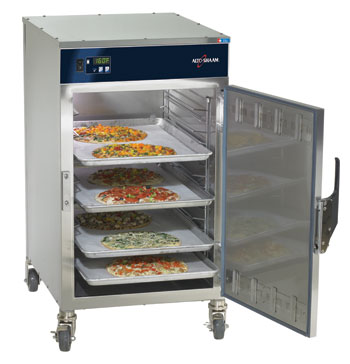Content sponsored by: Alto-Shaam
Holding equipment is not just for use in high-volume banquet applications, but can be an effective tool to improve food quality and speed of service in almost any foodservice operation. Below, Andy Mayeshiba, corporate chef at Alto-Shaam Inc. shares useful tips and valuable information to help make the most of these units.
 Instead of utilizing an intense low-volume heat source like other units, Alto-Shaam holding equipment features Halo Heat® technology that emits low intensity, high-volume heat.
Instead of utilizing an intense low-volume heat source like other units, Alto-Shaam holding equipment features Halo Heat® technology that emits low intensity, high-volume heat.
- The main goals for holding equipment are to maintain moisture, hold food at proper temperatures and retain the appropriate texture.
- These units come in a variety of formats, including wells, cabinets, hot food modules that appear built into tables for buffet use with pans or plates, hot deli cases, hot shelf modules for grab and go foods and drawers.
- One of the primary considerations when choosing hot holding equipment is whether food is moist or crispy. “Alto-Shaam units include door vents that can trap humidity inside when closed or be opened to allow additional steam to escape for crispy food,” says Mayeshiba.
- When holding crispy product, containers should not be over stacked. “Crispy fried chicken shouldn’t be held in deep containers or stacked, because steam will get trapped in the chicken,” says Mayeshiba. “By holding in a single layer, there is still some humidity for heat transfer, but not enough to compromise the product’s crispy texture.”
- Alto-Shaam’s dry drop-in holding wells utilize a heat source that is lower than traditional steam units. “True steam is 212 degrees F, so if food is exposed to this, it will continue cooking,” says Mayeshiba. “These types of holding unitswill emit too much heat for food served in a buffet setting, where pans are sitting for as long as four hours at a time.”
- With Alto-Shaam’s hot holding wells, the temperature can be adjusted to be lower than steam. “When using a lower temperature to protect food on the bottom of the pan, it's important to have a heat lamp or some type of radiant heat on top,” says Mayeshiba. “Otherwise, the cold environment will suck heat out of the product.” This is also true in retail applications like supermarkets, where open refrigeration can suck heat out of open hot wells, compromising holding temperatures.
- Many of the problems with hot holding are due to inefficient production systems. “It’s better to batch cook smaller amounts, only put out what is needed and hold food for an hour tops before replacing,” says Mayeshiba. “Cook-chill production is a good way to accomplish this, since operators can rethermalize a quarter of the food at a time for holding.”
- If the food being held is moist, it should remained covered, as this traps in steam and counteracts the drying process.
- Exact food temperatures are not typically maintained during the holding process. “Food that’s cooked to 180 degrees F only needs to be held at 140 degrees F,” says Mayeshiba. “Many times, operators rush into choosing a closed holding cavity when it's not always necessary.”
- If the food temperature is more than 160 degrees F, it’s important to allow time for steam to be released prior to containment in a holding cabinet. “Humidity is a good thing if food needs to be kept moist, but any items that are roasted or fried need time to rest out of the holding cavity,” says Mayeshiba. “If the food loses about 20 degrees of heat before the holding process, operators will notice a big difference in product quality.”
- When utilizing a flat surface for hot holding, it’s important not to use a plate or container with a raised bottom rim. This will compromise holding temperatures, since the produce is not directly on top of the heat source.
Learn more about the benefits of heated holding cabinets: www.alto-shaam.com/Holding-FES20150806.




